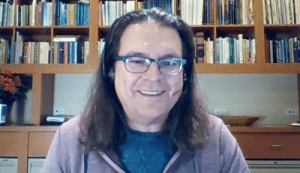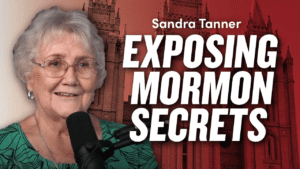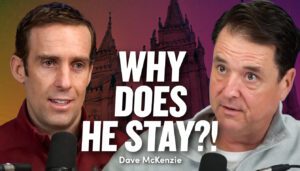 In this Mormon Stories Podcast interview, historian John Hamer discusses the 19th century historical and cultural context—largely forgotten today—that informed the composition of the Book of Mormon.
In this Mormon Stories Podcast interview, historian John Hamer discusses the 19th century historical and cultural context—largely forgotten today—that informed the composition of the Book of Mormon.
John Hamer graciously created a number of slides that give important visual cues to his research surrounding literary criticism of The Book of Mormon, possible literary influences for The Book of Mormon, multiple 19th century instances of writers attempting to tie ancient American artifacts to Israel, and much more. This interview may be best digested using our video editions below.
___________________________________
This interview is part of the Mormon Stories Podcast “Examining Mormon Truth Claims” initiative that involves a new set of essays being released at www.www.mormonstories.org/truth-claims and a billboard campaign on I-15. For more information on how you can help in this effort, please visit www.www.mormonstories.org/billboard.
Part 1 – We discuss literary criticism of The Book of Mormon:
Part 2 – We delve deeper into the 19th century worldview and context of The Book of Mormon’s creation:
Part 3 – We discuss different 19th century instances of writers attempting to tie ancient American artifacts to Israel:
Part 1
Part 2
Part 3
___________________________________
John Hamer is no stranger to Mormon Stories Podcast. Past episodes including contributions from John may be found here:
- 116-117: John Hamer – The LDS Succession Crisis of 1844 and the Beginnings of the RLDS Church to the Community of Christ
- 422-423: John Hamer on Returning to Mormonism Through the Community of Christ
- 503: Discussing the New LDS.org Polygamy Essays Part 1 — With Lindsay Hansen Park, John Hamer and J. Nelson-Seawright
- 526-527: John Hamer on Community of Christ as a Church Home for Transitioning Mormons
- 612-613: Reviewing 2015 with J. Nelson Seawright, John Hamer, Jamie Hanis-Handy, and Marisa Calderwood
- 796-797: LDS Church Purchases Printer’s Manuscript of Book of Mormon for $35M and BYU Now Serves Coke
- 1008-1009: Folk Magic, Joseph Smith, and Mormon Origins with John Hamer
___________________________________
Additional past Mormon Stories interviews referenced may be found here:
- 590-592: Stephen M. Veazey, Prophet-President of Community of Christ (Formerly RLDS Church)
- 904: Dr. Bart Ehrman – New Testament Scholar
- 1013-1016: David Bokovoy – Bible Scholar, Former CES Employee
- 1019-1022: David Bokovoy – Applying Higher Criticism to Mormon Scripture




17 Responses
Are you going to post the presentation slides here? Thanks.
Matthew, these are now hyperlinked in the blog description
I second this! Listening today and would love to click along
Question: Did Joseph Smith Jr. (and/or others at the time) believe that the Hill Cumorrah was built by the mound builders? I understand that it isn’t but what was the prevailing thought at the time?
I
This is one of the best podcasts you’ve ever done!
This was a fascinating and very thorough analysis of why the Book of Mormon was a 19th creation of gifted American steeped in the lore and beliefs of his surroundings. Completely convincing. However, that knowledge leads me to the inescapable conclusion that if the BoM is just a clever New York farm boy riffing on spiritual themes while assimilating the common knowledge of his times, why should anyone give his tale any special veneration or even consideration? Let alone the dedication of a life spent in worship as a Seventy. Why is Smith’s dictation of his made up religious story any different than those Michigan blackboard scribblings? Giving it attention as an historical or academic curiosity is one thing, but building an entire religious worldview around it is entirely another.
Do you know exactly where I can fin the Dewitt Clinton quote about a record of mound builders of engravings on stone or metal? Also do you think it would have printed in a news paper that the Smith family might of read? Thanks
What was the Naked Mormonism Podcast episode you referenced in this interview?
There just isn’t enough Hamer to go around. I could listen to his confident flow of erudition all day long. I learn so much about history.
To the Johns:
This article is horrifying but informative regarding European colonization of the Americas.
https://www.theguardian.com/environment/2019/jan/31/european-colonization-of-americas-helped-cause-climate-change
I loved this episode. Not only was it enlightening about the origin of the Book of Mormon, but learning more about American history was a real treat. A great combination. I especially appreciate gaining a deeper understanding of the forces that helped create Mormonism and so influenced the course of my life. Can’t wait to hear more of what John Hamer has to say!
Interesting to note that the ruins of Great Zimbabwe, first visited by Europeans in the 19th century, were met with a skepticism similar to that of the mounds of North America. Could not have been built by the indigenous peoples, lost white tribe, etc.
In part one, Hamer has a few slides that depict the gospels as scrolls. I believe this was only for presentation purposes and to create interesting visuals, so please do not think I’m trying to harshly criticize. Small point I’d like to share for feedback, that’s all. As I understand it, the early writings of Christianity were generally not written on scrolls like many other sacred writings of or before that time (Hebrew Bible). The gospels and other early writings of Christianity were written on papyrus and bound in book form. This is according to the work of Larry Hurtado, “The Earliest Christian Artifacts.” Scrolls have been found in the relics of Christian communities for sure, but the scrolls were usually of the Hebrew Bible. This is all according to Hurtado and my memory of his book. Again, such a minor point, but literary criticism often overlooks the medium of communication. Any feedback or correction is welcomed, but I found Hurtado’s work interesting in the arena of early Christian texts.
Quite right that Christians very quickly adopted the codex and helped popularize the new format. In my slides for texts later than the first century, I show icons as codices. For the first century, I have tended to show scrolls — papyrus can also be stitched together to make scrolls. As we don’t have any autographic texts, I’m not sure we can say whether the evangelists bound their originals as scrolls or codices. However, you’re quite right that we should be showing codices very early on in the Christian period.
After watching this, I’ve come to a conclusion that astonishes even myself.
The Mormon Church claims the Book of Mormon is scripture in the same sense as the Bible, and Joseph Smith was a prophet in the same sense as biblical prophets. My astonishing conclusion is, the Mormon Church is 100% right!
But the fine print in that conclusion is not good news for the church, or for any brand of Christianity that holds a literalist view of scripture. It’s that their perception of what scripture and prophets are is faulty. From what John Hamer shares with us, it appears that Joseph Smith produced the Book of Mormon in a very similar pattern to how all the writings of the Bible were produced, which indeed does make it “scripture as the Bible is scripture.” It’s just that the Bible is not scripture as the Mormon Church envisions scripture.
Enjoyed this podcast! Thanks for all the awesome slides and teachings about American history and the influence on the BOM text. I loved that the past insights from Dr. Coe, David Bokovoy, Dan Vogel, and even Stephen Veazey contributed to an fuller understanding of John Hamers brilliant insights! Looking forward to the next one!
You could definitely see your enthusiasm in the work
you write. The sector hopes for more passionate writers such as you who aren’t afraid
to mention how they believe. Always go after your heart.